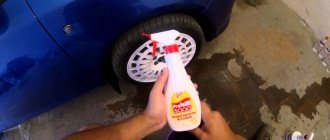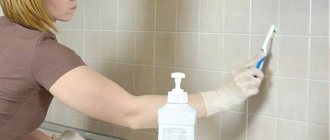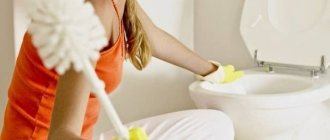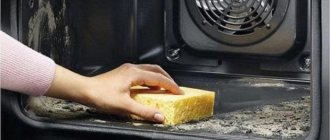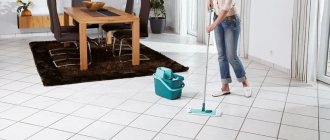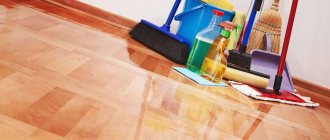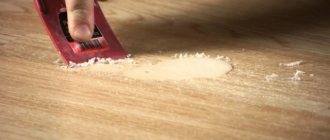Tile finishing implies a long and high-quality service life of the coating. But sooner or later you will have to face the problem of how to clean the seams between the tiles. During operation, various contaminants accumulate in them, including the formation of mold and mildew. Therefore, the relevance of this task is beyond doubt.
Reasons for changing the color of tile joints
After finishing work, the tiles please with their perfection, but after a while, the gaps between the tiles begin to darken and spoil the whole look. Even the most expensive ceramic coating loses its attractiveness because of this. Contamination of seams is a natural process that cannot be prevented, but its consequences can be reduced.
Grout aging occurs under the influence of an aggressive environment:
- bathroom, toilet - high humidity, household chemicals for bathing;
- kitchen working area and floor - humidity, drops of fat during cooking, food residues, etc.;
- floor in the hallway - sand, dust, dirt from outside.
To these reasons are added non-compliance with tiling technology and a number of operational issues:
- The base is not treated with a primer that protects against mold and mildew;
- The grout is not coated with a special protective compound;
- Seams that were not cleared of glue were rubbed;
- Lack of ventilation in the room;
- No heating;
- The surface is not maintained in a timely manner.
Initial contamination is an excellent environment for the development of fungus and mold. Fighting them is much more difficult. Therefore, periodic wet cleaning using household chemicals is recommended.
To protect the seams, special compounds are used, which are applied to the dried grout after finishing the facing work. Such measures reduce deep penetration of contaminants and ensure easy surface care.
Precautionary measures
Most often, various chemicals are used to remove glue, and they can be folk or commercial. They should be handled with care, as they can cause significant damage to human skin or mucous membranes, and they should not be inhaled.
When working, basic safety rules are taken into account:
- the process is carried out wearing protective gloves;
- it is not allowed to inhale the products;
- After work, the room is thoroughly ventilated.
There are different ways to remove glue from tiles. Their choice depends on whether the product has dried or not. It is important to comply with certain safety requirements.
In the toilet
This is a less aggressive environment. You can clean the tile seams on the floor using a sponge and a regular soap solution. In case of deep contamination, abrasive substances are used.
Separately, it is worth highlighting the cleaning of the surface and seams from tile adhesive. If the gaps between the tiles were not cleaned before applying the grout, then in case of severe contamination you will have to undo the joints between the tiles and reapply the solution. If the glue is visible in several places, then they are carefully cleaned with fine-grained sandpaper or partially embroidered and rubbed over again. Another method is special cleaners, which are purchased at hardware stores. It is important to know the brand of grout and glue.
Depending on the type of contamination, the type of room where cleaning is carried out, cleaning products and work methods are selected.
Features of cleaning walls and floors
Cleaning from dirt is easier on a horizontal plane (floor). You can lay rags soaked in special solutions on such a surface, wait for them to soften, and remove dirt.
It is difficult to do such actions on the wall. Here you need to constantly hold the dampened rags or periodically spray the product from a spray bottle.
It should be taken into account that the floor is covered with more stable coatings. It will be easier to clean them; they are less susceptible to scratching.
Chemical methods
This method involves the use of household chemicals. The composition is selected taking into account contamination. It is recommended to use chlorine bleaching agents for bathrooms. They will help get rid of fungus and mold if the stage of spread is not very advanced. For the kitchen - alkaline. These can be liquids, sprays. Oxygen bleaches are often used. They are diluted 1 to 2. You can bleach the seams using special markers, but this is a less effective method that will have to be repeated periodically. It helps get rid of stains, but not mold.
Traditional methods
This means washing with improvised means. Several compounds are used to remove pollution:
- Baking soda ¾ tbsp., hydrogen peroxide ¼ tbsp., dishwashing liquid 1 tbsp. l. The solution is applied with a brush using a rubbing motion. Waiting time 15 minutes. Wash off with water.
- Two solutions are made: soda with water 3:1 and vinegar with water 1:1. The first batch is rubbed into the dirt at the joints with a brush, and the second batch is sprayed through a spray bottle on top of the applied composition. After the reaction is completed, go through with a brush and wash off with water. Soda and vinegar achieve excellent results.
- Water 1 tbsp., citric acid 1/3 tbsp., soda ½ tbsp., vinegar ½ tbsp. The solution is mixed, applied to the seams with a brush, and left for 20 minutes. Wash off with warm water. Solutions with citric acid allow you to get rid of limestone deposits and rust.
Useful video: How to clean tile grout using home remedies?
Useful tips
The work can be done efficiently and effectively if you follow the recommendations:
- Perform actions with gloves, as some substances are aggressive.
- Start cleaning from the bottom and wipe the coating from the top with a dry cloth.
- If the tiles are glossy, it is better not to use a wire brush or abrasives to avoid cracks and scratches.
- It is better to use epoxy paint to protect the seam.
- Before using chemicals, you should study the instructions for use.
- It is not enough to clean the surface; you also need to dry it.
- Hydrogen peroxide is suitable for whitening grout lines.
Getting rid of stains on ceramics is not an easy task. It takes a lot of effort and time. Special detergents or improvised means are suitable for removal. The most important thing is to do everything right in order to get rid of problems for a long time.
Oxygen bleaches
Mix with water in a ratio of 1 to 2. Rub on contaminated areas. Allow up to 30 minutes to react. Treat with a brush and rinse with warm water.
With chemical and traditional methods, you should check the effect of the product in small areas. All of the listed compositions can give a whitening effect, which is not good for colored grout.
Cleaning the seams on the floor using folk remedies is quite easy. But we must remember that the work involves active chemical reactions. Therefore, you should take care of personal protective equipment: rubber gloves, respirator, goggles. They will help avoid chemical burns. They are also recommended for use when cleaning grout with chemicals. All of these methods are quite effective if the degree of spread of fungus and mold is minimal. If cleaning does not help, take drastic measures - updating the grout.
Safety regulations
Care must be taken while performing the work, as the chemical may come into contact with the skin and cause burns. In addition, when using adhesive cleaners, aggressive fumes are sometimes released from the tiles. For this reason, you need to prepare a respirator, protective gloves, and goggles.
If permitted by the manufacturer (information on operating conditions on the label), the cleaning procedure should be performed in a well-ventilated area. In cases where work must be carried out indoors, deep breathing is not recommended.
Replacing grout between tiles
What to do if all of the above effective methods did not help to clean the seams in the bathroom from mold? There remains one proven method - removing the old grout and applying new one.
To begin with, the facing layer is washed from all types of contamination. Take a seam sealer and clean it up. To speed up the process, a power tool (drill, grinder, screwdriver) is often used, but this increases the risk of damaging the tiles. To facilitate the process of grouting, solvents are used, but you should know what kind of grout was used previously. Or folk remedies: a solution of citric acid or vinegar. After cleaning, dirt and dust are removed, and special compounds are applied to the gaps to protect against mold and mildew and allowed to dry.
New grout is applied to the seams with a special rubber spatula. Excess is removed with a damp cloth. The grout has dried, the lining is washed from contamination, and the resulting seams are treated with an additional protective agent.
Removing the adhesive
Tile adhesive often ends up on the front side of the material, which happens when applied inaccurately, using too much of the product, or accidentally getting it from tools or hands. How to remove glue from ceramic tiles? The method depends on the time that has passed since the spots appeared and on their state - liquid or solid.
Liquid composition
It won’t be difficult to wash off the remnants of fresh glue from the wall or floor. You need to do the following:
- take a thick sponge, moisten it with water, squeeze it out,
- remove dirt from the tiles, rinse the sponge,
- repeat the operation the required number of times,
- when the glue is difficult to wash off, take a hard (dry) rag and rub the contaminated areas with force.
If the glue has already begun to harden a little, you can use a construction float. It must be used to process the area, holding the tool vertically. In this case, it is important to make movements diagonally - this way the adhesive in the tile seams will not be damaged. There is no need to make any special efforts, otherwise scratches and abrasions may remain on the tile. When the glue stains have completely hardened, you can sprinkle them with water and then repeat the manipulations with the grater.
Hardened composition
To remove old hardened glue you will have to make more serious efforts. It is usually recommended to use a mechanical method or chemical solvents. Before removing the glue, you need to spray the tiles with water from a spray bottle. You can also use various available tools:
- take a rubber or plastic spatula, scraper, carefully scrape off any drops of glue,
- scrape off the glue with a plastic card, after softening it,
- treat difficult areas with construction pumice (you must work carefully so as not to leave scratches),
- wipe the base with a melamine sponge,
- polish the walls with a microfiber cloth (after spraying with water).
It is not advisable to use metal tools or hard metal brushes to clean the tiles, or you should perform all actions very carefully, because the tiles may break. On the contrary, it is better to clean excess mortar from tile joints using a drill with an attachment (metal brush). It perfectly cleans the grooves and prepares them for applying grout.
How to protect grout joints from contamination
Everyone chooses how to clean the seams themselves. Having achieved the original appearance of the grout, it is better to apply a special protecting solution to it. It will fill microcracks and pores in the putty. This ensures maximum ease of care. The joints will be washed easily, like cladding. The process of applying protective fluid requires precision. A thin brush is used for it, and the solution is distributed exactly along the seam. Do not stain the tiles. After the protective solution has dried, the surface of the tile is difficult to clean, and over time these places will turn yellow. Therefore, such processing requires accuracy and should not be rushed.
Another important protective factor for tile holes is constant care using household chemicals. This will keep the grout pristine for up to 10 years.
Types of tile adhesive
Modern industry produces tile adhesive in several types: epoxy and cement. Cement-based grout is an inexpensive but durable material that contains polymer and sand.
This grout takes a long time to dry after application and it is not difficult to clean the tiles from it, especially if you do this before the glue has completely dried.
- Epoxy resin grout hardens very quickly and is more difficult to remove than its cement counterpart.
- It is best to wash off epoxy grout in the first 24 hours; then it will be very difficult to remove traces.
- There are special chemical compounds designed to clean tiles from fugue.
When buying a special cleaning product, you need to pay attention to what type of glue it is intended for.

